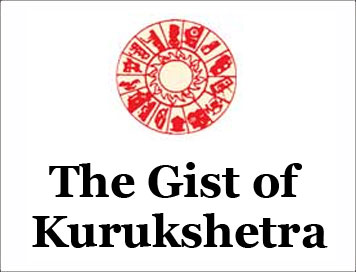(HOT) UPSC Current Affairs 2025 PDF
NEW! The Gist (NOV-2025) | E-BOOKS
(GIST OF KURUKSHETRA) Water management through Panchayati Raj Institutions
(GIST OF KURUKSHETRA) Water management through Panchayati Raj Institutions
(APRIL-2025)
Water management through Panchayati Raj Institutions
Introduction:
The word “Panchayat”, meaning “seat of five” -panca, has Sanskrit origin. The concept of panchayat system has been in existence for quite long, and finds its roots in ancient India. In 1992, the 73rd constitution amendment act, has provided a new and broader dimension to the system and empowered the panchayats to deal with the subjects listed under the schedule XI of the constitution, which inter-alia includes drinking water, minor irrigation, water management and watershed development.
Background:
This amendment was the first stern step in converging the concepts of decentralization of power, participatory approach, and local level water management. As of now, there are about 2.69 lakh panchayats across the country, covering a population of about 95.66 crore. As per the first water body census conducted by the Ministry of Jal Shakti published in 2023, out of the 24.25 lakh water bodies enumerated in the country, 97.1% are in rural areas.
The PRIs are expected to actively intervene by:
-
Establishing, fostering, and fortifying organizations (standing committees, subcommittees, and department committees) to address various related concerns and challenges.
-
Ensuring participation in Gram Sabhas to broaden the basis for decisions pertaining to water.
-
Including all Cram Panchayat residents in decision making to establish and preserve the water resources.
-
Promoting water body conservation, and protection against encroachment.
-
Encouraging women participation in decision making and thereby paving the way for gender
Participatory Irrigation Management (PIM)
-
Irrigation sector is the largest consumer of water resources by using about 90% of available water. The participatory irrigation management (PIM) aims to emphasize farmer involvement in all stages of irrigation system management, aiming for improved efficiency, sustainability, and performance of irrigated agriculture.
-
Under the PIM principles, the Government agencies focus on constructing and maintaining irrigation network till farm outlets, and the farmers or beneficiaries manage water distribution and infrastructure maintenance at farm level.
Rural Drinking Water Schemes
-
Access to clean and safe drinking water is vital for a healthy community. Management of the rural water supply system cannot be seen as an option or choice between the state government and the Gram Panchayat. It is a fundamental approach towards a management system wherein a full collaboration between the government and Gram Panchayat is achieved.
-
The state government as well as the Gram Panchayat have clearly defined and established roles that are separate from one another. It is essential that each of them understands and accepts the same. The Governments, both national and sub-national, have started to focus on rural drinking water sector since 1970s.
Water bodies in Rural areas
Water bodies are an integral part of fresh water resources. Technically, all natural or man-made units bounded on all sides with some or no masonry work used for storing water for irrigation or other purposes (e.g. industrial, pisciculture, domestic/drinking, recreation, religious, ground water recharge etc.) will be treated as water bodies. Ministry of Jal Shakti conducted the first water body census along with the 6th Minor Irrigation census and published the data in 2023.
MGNREGS and water Conservation
Mahatma Gandhi National Rural Employment Guarantee Scheme (MNREGS), implemented through PRIs, has provisions for public works relating to water conservation and water harvesting structures to augment and improve ground water like underground dykes, earthen dams, check dams and roof top rain water harvesting structures in public buildings.
In 2014, the amendment to MGNREGS Schedule-1 was done which mandates that at least 60% expenditure will be on agriculture and allied activities. Consequently, a list of permissible works under the Act now has nearly 75% activities that directly improve the water security and water conservation efforts. The water conservation works under MGNREGS is included in its Natural Resource Management (NRM) works.
Village Level Water Budgeting
A water budget is estimation of the requirement and availability of water in a region or in a Grama Panchayath (GP). After obtaining information about various sources and water supply schemes available, the village water security planning team (team formed for developing water security including VWSCs, functionaries, volunteers, etc.) along with the GP prepares a water budget which is required for the preparation of a source sustainability plan. A water budget facilitates three things:
-
Estimates how much water is available to the GP from various sources and compares it with how much water is required for various types of uses,
-
Bridges the gap between availability and demand, after which the GP must take an overall view from the point of view of the good of the community as a whole and discuss and decide the appropriate priorities for supplying water for different purposes. After giving first priority to drinking water for human and animal consumption, the GP can decide on need-based allotment for other sectors such as agriculture, industries, etc.
-
Identifies and quantifies the gap between available water from various sources and the water needed, and thus enables the preparation of a ‘water source sustainability plan’ by the planning team which is expected to identify various options to increase water availability.
Groundwater sector
-
Groundwater is a major source to agriculture, drinking water and industrial needs, and often suffers over exploitation in many areas. It is important to deal with this issue with people participation.
-
Atal Bhujal Yojana (ABY), a central sector scheme for sustainable groundwater management, emphasizes community participation and demand-side interventions, with a focus on involving PRIs (Gram Panchayats) in the preparation and implementation of water security plans: The scheme is implemented through a combination of government agencies, District Implementation Partners (DIPs), and Support Organizations (SOs) to facilitate community participation and ensure the successful implementation of Water Security Plans.
Way Forward
Challenges in water management is expected to exacerbate in the backdrop of climate change impacts, and growing demands. Preservation of local water resources - both surface and ground water - is key to achieving water security which could be accomplished only through Jan Bhagidari (people participation). Further, there should be a paradigm shift to embrace the idea “water is everyone’s business”, not just that of Government agencies. PRIs should encourage communities and water user groups to take up the responsibility of operation and maintenance of the infrastructure for drinking water supply and irrigation. Only through collective effort (sabka saath), we can achieve inclusive growth (sabka vikas).
CLICK HERE TO DOWNLOAD FULL PDF
CLICK HERE TO DOWNLOAD UPSC E-BOOKS
Study Material for UPSC General Studies Pre Cum Mains
Get The Gist 1 Year Subscription Online
Click Here to Download More Free Sample Material
<<Go Back To Main Page
Courtesy: Kurukshetra



